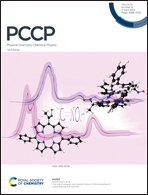Kinetics and dynamics study of the Cl(2P) + CH3OH reaction based on an analytical potential energy surface
Abstract
The reaction of chlorine atoms with methanol plays a central role in atmospheric and combustion processes and is a prototype of multi-channel reaction with two paths, HCl(v,j) + CH2OH (R1) and HCl(v,j) + CH3O (R2). In order to understand the kinetics and dynamics of the title reaction, using a valence-bond (VB) strategy we developed a new full-dimensional potential energy surface, named PES-2023, fitted to high-level ab initio calculations. Given that the (R2) path shows a noticeable barrier height, 12.7 kcal mol−1, while the (R1) path presents a submerged transition state with respect to the reactants, the latter is the kinetically favoured path on which most experimental kinetics and dynamics studies have focused. The PES-2023 surface presents a smooth and continuous behavior and is free of spurious features. Quasi-classical trajectory calculations were performed on this surface in order to shed light on the reaction kinetics and dynamics. The thermal rate constants in the temperature range 200–1000 K are practically independent of temperature, reproducing recent experimental evidence, although the experimental kinetics isotope effects are not well simulated. In the dynamics study the product distribution energy and the HCl(v,j) product roto-vibrational energy reasonably simulate the experimental data, where only the v = 0 and v = 1 vibrational states are populated, 80–20%, respectively. We found that both HCl(v) vibrational states present similar forward scattering distributions, associated with a stripping mechanism. This theoretical result contrasts with some of the previous experimental measurements. Finally, PES-2023 was compared with a recent and accurate full-dimensional surface based on a different strategy, a molecular orbital (MO) based surface, fitted to a very large number of ab initio points, concluding that both surfaces present similar behaviour, where some kinetics and dynamics properties are better reproduced by one surface and other properties by the other.



 Please wait while we load your content...
Please wait while we load your content...